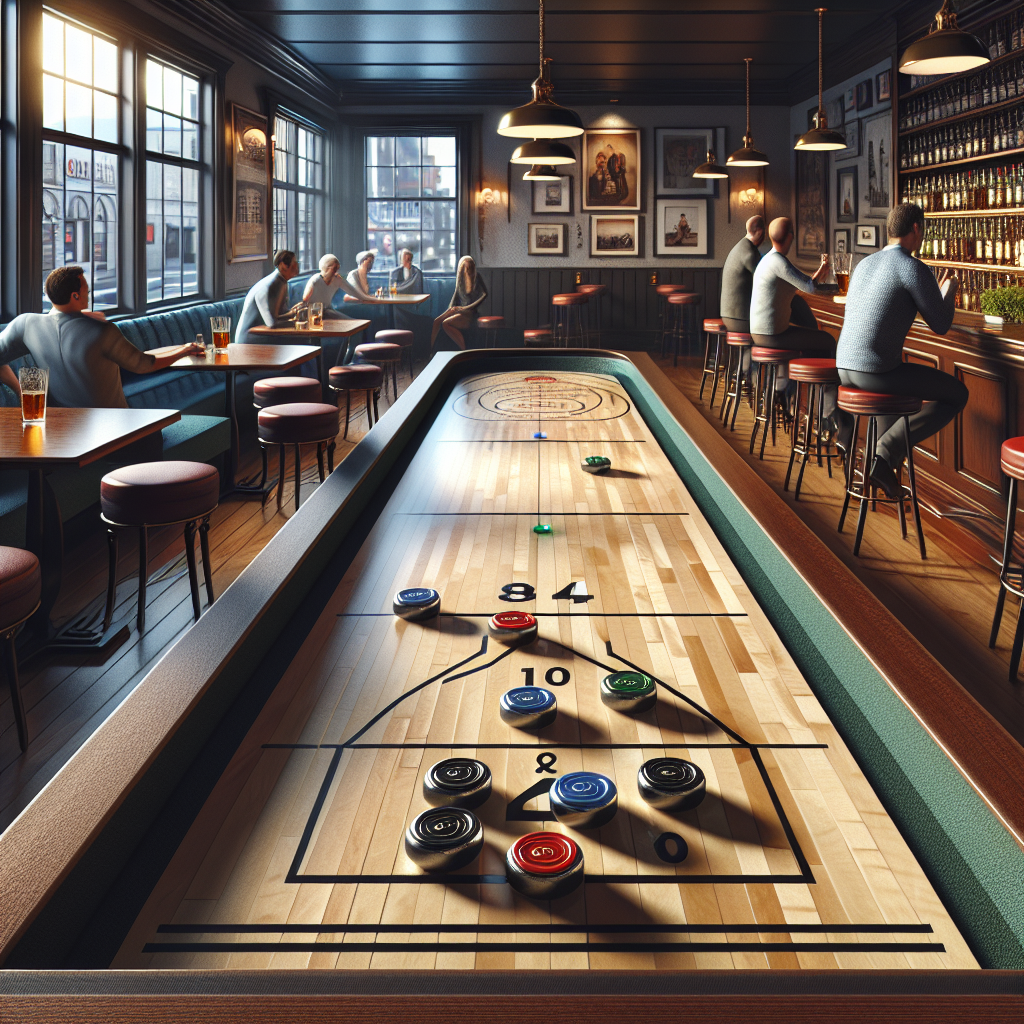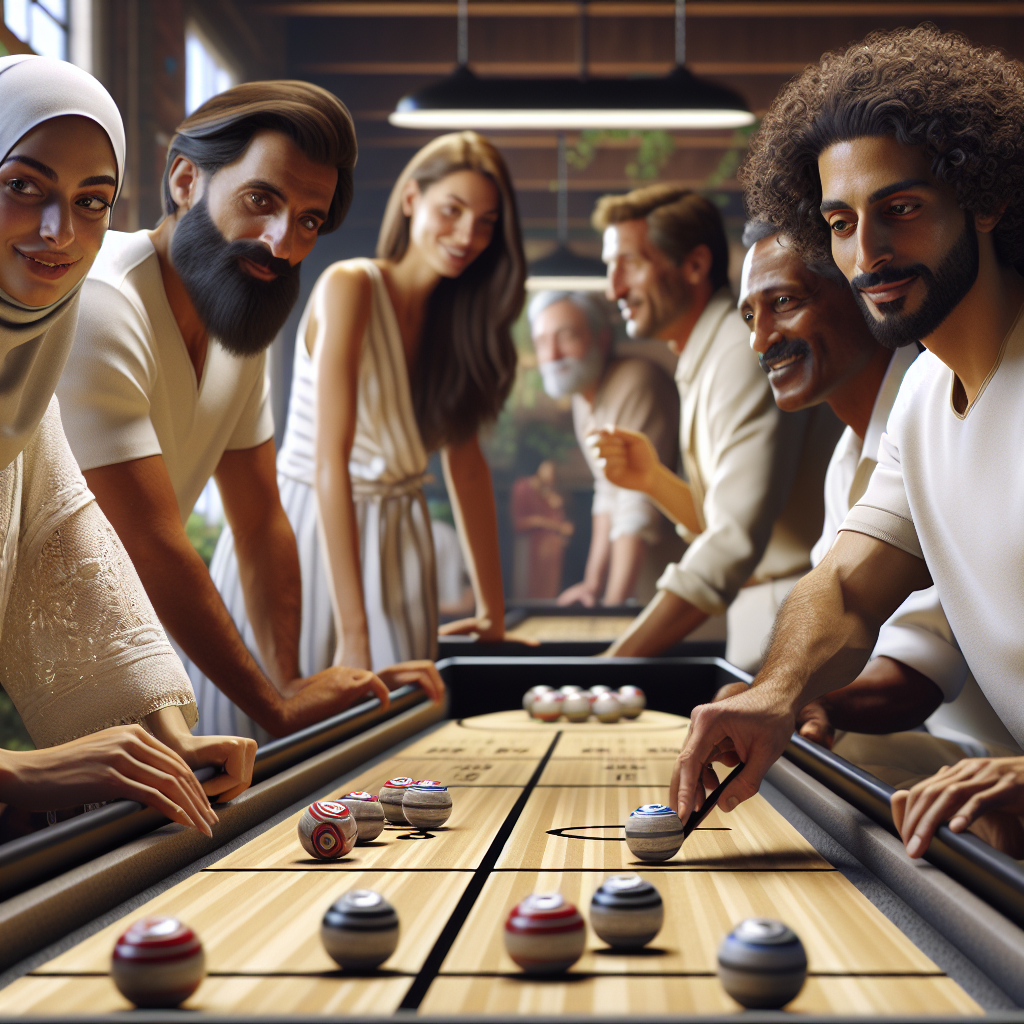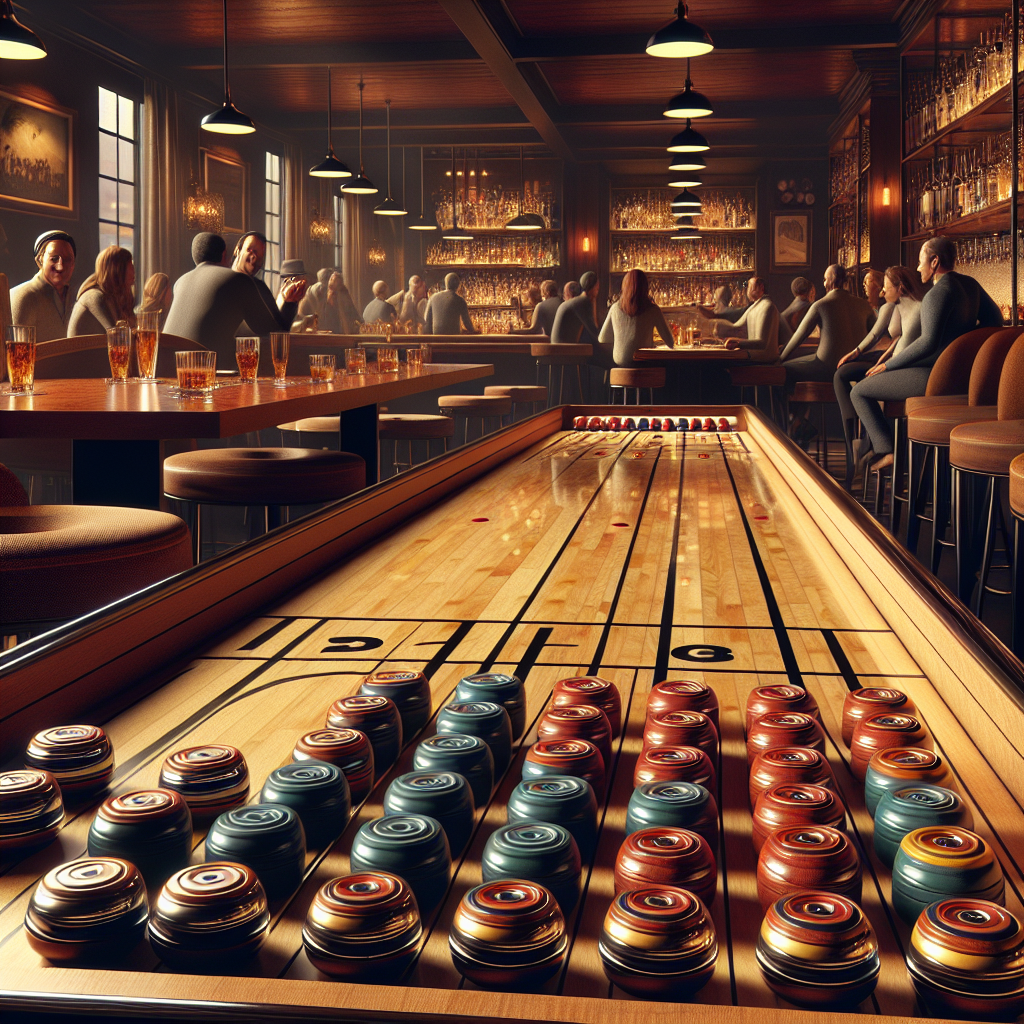Understanding Shuffleboard Rules
To fully enjoy the game of bar shuffleboard, it’s essential to familiarize yourself with the rules and strategies. By understanding the basic gameplay rules and strategic considerations, you can enhance your playing experience and increase your chances of success.
Basic Gameplay Rules
Shuffleboard games are typically played to either 15 or 21 points. The objective is to slide all four of your weights alternately against your opponent’s weights, aiming to reach the highest scoring area without falling off the board (McClure Tables).
The scoring areas on the shuffleboard table are divided into different zones, each with its own point value. The outermost zone, known as the 1-point zone, is followed by the 2-point, 3-point, and so on. The highest scoring area is typically located at the far end of the table.
Players take turns sliding their weights, aiming to land them in the highest scoring area possible. In addition to scoring points, players can strategically knock off their opponents’ weights, outdistance them, or use their weights to protect their highest scoring weights (McClure Tables).
It’s important to note that different shuffleboard games may have variations in rules and scoring methods. Some popular shuffleboard game variants include Knock Off Shuffleboard, Horse Collar Table Shuffleboard, Tap & Draw Shuffleboard, How To Play Shuffleboard Crazy Eight, and Target Table Shuffleboard (McClure Tables). Familiarize yourself with the specific rules of the game you’re playing to ensure a fair and enjoyable experience.
Strategic Considerations
While shuffleboard may seem like a simple game, strategic considerations can greatly influence your chances of winning. Here are some key strategic factors to keep in mind:
-
Weight Placement: Aim to strategically position your weights to maximize your scoring potential while minimizing the chances of your opponent knocking them off the board. Placing weights strategically in front of opponents’ scoring weights can act as a barrier, making it difficult for them to score.
-
Precision and Control: Developing good control over your shots is crucial. Practice your aim and technique to consistently hit the desired scoring areas. Mastering the art of consistently landing weights in the highest scoring zones will give you a significant advantage.
-
Reading the Board: Pay attention to the playing surface and observe how weights react to different areas of the table. Factors such as the table’s condition, wax coating, and any irregularities can affect how weights slide. Adjust your strategy accordingly.
-
Timing and Weight Distribution: Consider the order in which you slide your weights. Placing heavier weights strategically can dislodge opponents’ weights or protect your own scoring weights. Experiment with different weight distribution strategies to find what works best for you.
By understanding and implementing these strategic considerations, you can elevate your shuffleboard game and increase your chances of winning.
Remember, shuffleboard is a game of skill and strategy. Practice, observe, and adapt your techniques to become a master of the bar shuffleboard table. For more tips and techniques to improve your shuffleboard skills, check out our article on bar shuffleboard tips.
Shuffleboard Table Sizes
When it comes to bar shuffleboard, the size of the shuffleboard table plays a significant role in the gameplay experience. In this section, we will explore regulation size tables and considerations for choosing the right size for your bar.
Regulation Size Tables
Regulation size shuffleboard tables are typically 22 feet long by 20 inches wide. However, it’s important to note that the cradle, which houses the playing surface, adds a few inches to these dimensions. As a result, the actual size of a regulation shuffleboard table is around 23 feet long and 31 inches wide.
To accommodate a regulation size shuffleboard table, a room that is at least 26 feet long and 8 feet wide is required. This allows players to maneuver comfortably around the table while playing. Regulation size tables are commonly used in professional tournaments and offer a challenging playing experience.
Choosing the Right Size
When it comes to bar shuffleboard tables, there are various sizes to choose from, ranging from 9 feet to 22 feet in length. The size you choose should depend on the available space in your bar and the desired challenge level for players.
Table length significantly impacts the difficulty and challenge of the game. Longer tables require players to develop more accuracy and precision in their shots, as the distance between targets increases. On the other hand, shorter tables are more suitable for beginners or casual players.
Here are some general guidelines for choosing the right size shuffleboard table for your bar:
| Table Length | Suitable For |
|---|---|
| 9-12 feet | Smaller bars or limited space |
| 14-16 feet | Intermediate skill level and moderate space |
| 18-22 feet | Larger bars or experienced players looking for a challenge |
It’s essential to consider the available space and traffic flow in your bar when selecting a shuffleboard table. Ensure that there is enough room for players to comfortably play while still allowing space for spectators to observe the game.
Additionally, the thickness of the playfield should also be considered. Thicker playfields provide better durability and can withstand the demands of a busy bar environment. Thinner playfields, while less durable, may be suitable for bars with less frequent play.
By considering the size of your bar and the skill level of your patrons, you can choose a shuffleboard table that suits your establishment’s needs. Whether you opt for a regulation size table or a smaller size, providing a well-sized shuffleboard table will enhance the playing experience for your customers and add an enjoyable social activity to your bar.
Building a Shuffleboard Table
If you’re feeling adventurous and have some woodworking skills, building your own shuffleboard table can be a rewarding and cost-effective project. In this section, we will provide an overview of the DIY process and discuss the materials and construction steps involved.
DIY Project Overview
Before diving into the details, it’s important to note that building a shuffleboard table requires intermediate woodworking skills. It is recommended for individuals who have some experience and knowledge in woodworking. If you’re up for the challenge, the satisfaction of playing on a table you built yourself can be well worth the effort.
Jamison Rantz, a former aerospace engineer turned DIY furniture enthusiast, provides detailed and easy-to-follow instructions for building a 14-foot shuffleboard table on Rogue Engineer. The estimated time to complete the project is about one week, making it a relatively quick DIY endeavor.
Materials and Construction Steps
To get started, you’ll need to gather the necessary materials. The main components of a shuffleboard table include the playing surface, the frame, and the legs. Here is a list of the materials you’ll typically need:
- Butcher block countertops or plywood with oak flooring for the playing surface.
- Lumber for the frame and legs, such as pine or maple.
- Screws, wood glue, and a variety of woodworking tools.
Once you have your materials ready, you can begin constructing your shuffleboard table by following these general steps:
-
Measure and cut the playing surface according to the desired dimensions. A regulation shuffleboard table measures 22 feet long and 20 inches wide (bar shuffleboard dimensions), but you can adjust the size to fit your space.
-
Assemble the frame using the lumber. This frame will provide stability and support for the playing surface.
-
Attach the legs to the frame, ensuring they are securely fastened. The height of the table should be comfortable for players to stand and play.
-
Install the playing surface onto the frame, making sure it is level and securely attached.
-
Finish the table by sanding the playing surface and applying a protective finish, such as polyurethane, to protect it from wear and tear.
It’s worth noting that the playing surface of a shuffleboard table requires special attention. Epoxy can be used to create a smooth and durable surface. However, for optimal gameplay, it’s important to pour or move the epoxy to the sides first and allow it to settle in the middle to create a concave surface. Pouring from the center can result in a slightly convex surface.
By following the detailed instructions provided by Jamison Rantz on Rogue Engineer, you can build your own shuffleboard table and enjoy countless hours of fun and friendly competition.
Remember, building a shuffleboard table is a project that requires time, effort, and woodworking skills. If you prefer a ready-made option, there are commercial shuffleboard tables available (bar shuffleboard equipment) that can save you the construction process. Consider your preferences, skills, and resources before deciding on the best option for you.
Bar Shuffleboard Tables
Bar shuffleboard has made a comeback in recent years, becoming a popular game in drinking establishments. Many manufacturers have entered the market to cater to different needs and user bases, including bars (Shuffleboard.net). Investing in a shuffleboard table for a bar can enhance customer satisfaction, improve patron flow, and increase retention by creating a fun atmosphere for patrons to enjoy the game (Shuffleboard.net).
Commercial Options
When it comes to bar shuffleboard tables, there are various commercial options available. These tables are specifically designed for the demands of a bar setting, with features that prioritize durability and gameplay experience. Commercial bar shuffleboard tables are typically built to withstand heavy use and are constructed using high-quality materials.
It’s important to consider factors such as the size of the bar area and the available space when choosing a bar shuffleboard table. Tables come in a variety of sizes ranging from 7′ to 22′, catering to different needs and space requirements (Wayfair). Selecting the appropriate size ensures that the table fits comfortably within the bar area, allowing patrons to play without feeling cramped.
Factors to Consider for Bars
When selecting a shuffleboard table for a bar, there are additional factors to consider beyond size. These factors can greatly impact the gameplay experience and the overall suitability of the table for the bar environment.
-
Materials: Manufacturers use different woods, thicknesses, and finishes in their shuffleboard tables, impacting gameplay, endurance, and aesthetic appeal. The choice of materials can affect the production cost and, consequently, the price of the shuffleboard table (Shuffleboard.net). It’s essential to choose a table constructed with durable materials that can withstand the demands of a bar setting.
-
Maintenance: Considering the maintenance requirements of a shuffleboard table is crucial for bars. Tables that are easy to clean and maintain help ensure that the game remains enjoyable for patrons. Regular cleaning and waxing of the playing surface are necessary to maintain optimal gameplay and prolong the lifespan of the table.
-
Scoring System: Some commercial bar shuffleboard tables come with built-in scoring systems, making it easier for players to keep track of their scores. These systems can enhance the overall playing experience and reduce the need for manual scorekeeping.
By considering these factors and selecting a high-quality shuffleboard table designed specifically for bar settings, you can create an engaging and entertaining atmosphere for your patrons. Installing a shuffleboard table in your bar can provide a great source of entertainment and enjoyment, attracting new customers and keeping them coming back for more shuffleboard fun.
Remember, for more information on how to play bar shuffleboard, scoring techniques, equipment, and maintenance tips, check out our articles on bar shuffleboard rules, bar shuffleboard scoring, bar shuffleboard equipment, and bar shuffleboard maintenance.
Shuffleboard Table Materials
When it comes to bar shuffleboard tables, the choice of materials used plays a significant role in the overall gameplay experience, as well as the aesthetics and durability of the table.
Impact on Gameplay
Shuffleboard tables are constructed with different materials, and the thickness of the playing field can range from 1.5 to 3 inches. The surface finish of shuffleboard tables has evolved from traditional options like shellac or lacquer to modern materials such as epoxy and polyurethane synthetic polymers. These modern finishes provide enhanced durability, resistance to damage, and a smooth playing surface that allows the pucks to glide effortlessly.
The surface board of a shuffleboard table is typically designed to be slightly concave. This intentional curve helps to prevent the pucks from flying off the sides and provides a more challenging and strategic playing experience. The combination of materials and craftsmanship determines the level of concavity and the overall quality of the playing surface.
To ensure optimal gameplay, it’s crucial to select a shuffleboard table with a high-quality playing surface that offers consistent speed and smoothness. The choice of materials directly affects the performance of the pucks and the overall enjoyment of the game.
Aesthetics and Durability
In addition to gameplay considerations, the materials used in the construction of a shuffleboard table also contribute to its aesthetics and durability. Shuffleboard tables are often crafted using hardwoods like maple or mahogany, known for their strength and longevity. These materials provide a solid and sturdy base for the playing surface.
The cabinet of a shuffleboard table not only supports the playing surface but also contributes to the overall appearance. The design and craftsmanship of the cabinet can vary, allowing for customization and personalization. The cabinet also helps regulate temperature and humidity, ensuring the playing surface remains in optimal condition.
Manufacturers use different types of woods, thicknesses, and finishes in their shuffleboard tables, resulting in variations in aesthetics and endurance. The choice of materials impacts the production cost and, consequently, the price of the shuffleboard table. It’s important to consider your preferences for appearance and long-term durability when selecting a shuffleboard table for your bar.
To maintain the playing surface and the overall condition of the table, regular maintenance is essential. This includes cleaning the surface, applying shuffleboard wax or powder, and ensuring the table is properly protected when not in use. By following proper maintenance practices, you can extend the lifespan of your shuffleboard table and continue to enjoy smooth gameplay.
In conclusion, the choice of materials in a shuffleboard table greatly influences the gameplay experience, the table’s durability, and its visual appeal. Consider factors such as the playing surface materials, cabinet construction, and overall craftsmanship when selecting a shuffleboard table for your bar. By choosing a high-quality table that suits your preferences, you can ensure hours of competitive fun for your patrons.
Shuffleboard Table Pricing
When considering purchasing a shuffleboard table, understanding the pricing options is essential. Shuffleboard tables can vary significantly in price, depending on factors such as quality, materials, craftsmanship, and brand reputation. In this section, we will provide an overview of the price ranges for shuffleboard tables and discuss the factors that influence their cost.
Price Range Overview
Shuffleboard table prices can range from $500 for entry-level tables to over $5,000 for high-end options. Here is a breakdown of the general price ranges:
| Price Range | Description |
|---|---|
| $500 – $1,000 | Entry-level tables with basic features and construction |
| $1,000 – $3,000 | Mid-range tables with better quality and durability |
| $3,000 and above | High-end tables offering superior quality and gameplay |
It’s important to note that high-end shuffleboard tables, including handcrafted and made-to-order options, can cost even more, ranging from $6,000 to $10,000 (Triangle Billiards). On the other hand, readymade tables of decent quality can be found in the range of $2,000 to as low as $800.
Factors Influencing Cost
Several factors contribute to the pricing of shuffleboard tables:
-
Quality and Craftsmanship: Higher-priced tables often offer superior quality and durability. They are constructed with high-quality materials, ensuring longevity and endurance through heavy use (Shuffleboard.net). Handcrafted tables, in particular, are known for their exceptional craftsmanship and attention to detail, making them more expensive.
-
Materials Used: The type of wood, thickness, and finish used in the construction of shuffleboard tables impact their overall quality, aesthetics, and gameplay experience (Shuffleboard.net). Tables made from high-quality hardwoods tend to be more expensive due to the cost of materials and the durability they offer.
-
Brand Reputation: Established brands with a reputation for producing high-quality shuffleboard tables often come with a higher price tag. These brands have built trust over time through their commitment to exceptional craftsmanship and customer satisfaction.
Investing in a shuffleboard table for a bar can enhance customer satisfaction, improve patron flow, and increase retention by creating a fun atmosphere for patrons to enjoy the game (Shuffleboard.net). When considering the cost of a shuffleboard table, it’s important to weigh the benefits it brings to your establishment against the initial investment.
By understanding the general price ranges and the factors that influence the cost of shuffleboard tables, you can make an informed decision when selecting a table that meets your budget and quality requirements. Whether you opt for an entry-level table or a high-end option, investing in a shuffleboard table can bring hours of enjoyment and entertainment to your bar or game room.








